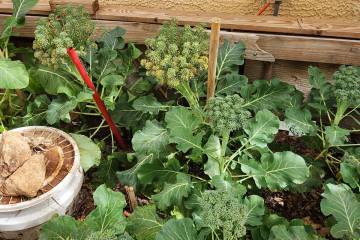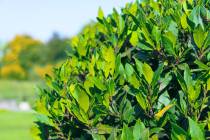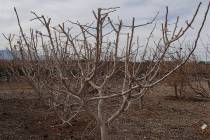Sanitation, pruning key to removing diseased parts of plant
Q: We have lost a tremendous section of our garden. In researching, it appears fire blight disease is the problem. Our red-tip photinia was the first and, in a very short time, it looked as if someone had taken a flame thrower to the plants. Euonymus hedges, flowering pink hawthorn and some rose bushes are starting to show the same problem.
A: It is possible, particularly because of the wet spring, but not for euonymus or Indian hawthorn. This disease would usually hit only plants in the rose family: photinia, pyracantha, apple, pear, seldom roses.
Asian pear and quince are particularly hard hit. It can be a problem if it is not dealt with right away. But if it is attacking plants not in the rose family, then you would rule out fire blight.
Pruning is really the only alternative. Prune a good 12 inches below where you see problems. Sanitize between each cut and between each plant. Dispose of this infected debris immediately and get it off the property.
If the disease has entered the main stem or trunk then it will be impossible to remove and the entire plant should br taken out. It does not survive in the soil, so it is safe to replant even with the same plants.
But sanitation and pruning out the infected parts are the key to keeping it restrained. It doesn’t typically spread this time of year and entry points are usually at flowers and pruning cuts, open fresh wounds.
Q: My No. 1 enemy is small grass snails that destroy the roots. Is there a product that will eliminate these pests? We also have a desert tortoise and dogs and would not want to harm them.
A: Here are the options as I understand them for snails and slugs. Basically, slugs are snails without the shell so they are treated about the same.
Sluggo is a commercial bait that is advertised as safe for pets. It is a combination of iron and phosphorus but concentrated. Apply every two weeks around plants; the soil should be moist but no standing water. Since they come out at night, apply it at dusk.
Lay wet newspaper and cardboard on the surface of the soil between plants where there are problems. In the morning, pull up the newspaper and cardboard, and you will see them having a party. Collect them and dispose of them.
Open some cans of beer and let them sit for one day to get stale. Pour the beer into shallow dishes in the garden, and the slugs will think there is a party. In all of their excitement, they drown in the stale beer. Collect them, dispose of them and put more stale beer out.
I have been told that a ring of aluminum foil around plants will keep slugs from getting to them. I have never tried it.
Maybe some readers have some good ideas. Let’s let them comment on mine or the RJ’s blog about this.
Q: We purchased a Fuji apple tree and the tag says that the apples are self-fertile. Everything we see on the internet says that is not so.
A: A comment on terms: Pollinators are insects such as bees and moths. Pollenizers are trees needed to set fruit on other trees.
A little-known fact is that pollenizer trees are region specific. We can’t follow the rule “one size fits all” regarding the selection of pollenizers for fruit trees. A pollenizer fruit tree that works on the West Coast may not work on the East Coast and vice versa.
A good site to reference for our area regarding whether a fruit tree needs pollinizer or not is the Dave Wilson Nursery website found at www.davewilson.com
The information I have is that Fuji does not require a pollenizer in our area. Some fruit trees will set fruit without a pollenizer but set a heavier crop with one.
This can be sometimes good and sometimes bad because of thinning or removing the fruit to get larger ones.
Q: I want to get rid of a Bermuda grass lawn. I overseeded it last fall with perennial rye and the ryegrass has all but died from the heat, and the Bermuda looks bad. I would like to reseed it to fescue grass this September. How do I get rid of the remaining Bermuda, what variety of fescue do you recommend and what procedures to follow? I want a green lawn year around, if possible.
A: The usual reasons people want fescue lawns over Bermuda grass is because Bermuda grass turns brown, or becomes dormant, in the winter. Tall fescue doesn’t if you fertilize it late in the year. Also, tall fescue requires less work to maintain than Bermuda grass.
When overseeding Bermuda grass, people should use heat-tolerant perennial ryegrass such as Palmer or Prelude rather than the heat-sensitive types. It is a lot less work and it looks better.
Once you have a Bermuda grass lawn it can be a bit difficult to convert it to tall fescue. But the way I would do it is to spray the grass with Roundup and remove it with a sod cutter about one week after it is sprayed.
It will still be green but it’s dying. The Roundup requires 12 to 24 hours to move into the roots of the Bermuda grass. The grass looks alive and healthy after 24 hours, but it is dying and will continue to die over several days.
Once the Bermudagrass sod has been removed, continue to water and fertilize the remaining bare soil where it was removed. This will push any Bermudagrass growth in a few days that is still alive if temperatures are warm. When you see this remaining growth emerge, spray it with Roundup.
A less expensive way — but one that involves seeding — is to mow the Bermuda grass to about one-half inch, bag the clippings, then spray it with Roundup. Spray it twice; once from north to south and the second time from east to west to make sure you get good spray coverage.
After one week, mow the Bermuda as close to the ground as you can. and dethatch or vertical mow it. You will need to rent a dethatcher or vertical mower to do that. Go over and over the lawn until you see bare soil.
Remove this debris. You can seed directly into this area if you wait at least one week after the last Roundup application.
Tall fescue sod or seed can be planted about one week after you spray Roundup. Your window for planting tall fescue from seed or sod is the middle of September until the end of October. So plan accordingly.
There are a lot of good tall fescue varieties out there. Just stay away from K–31, which also is called Kentucky 31. I call this a highway grass. Why? It looks good at 50 mph.
Look at the label on the bag of tall fescue. The more varieties in the bag, the better. When it comes to grass seed, you get what you pay for. The better, newer varieties are more expensive. Plan on about 10 pounds of grass seed for every 1,000 square feet of lawn.
Q: I have a 2-year-old Li jujube plant. When I bought it, it had lots of fruits. For the past two years, the plant would flower, but the fruits never developed. I’ve read that jujubes are self-pollinating. If not, should I consider getting a Lang jujube to cross-pollinate?
A: Li jujube fruit is round and Lang jujube fruit is pear-shaped. Yes, if you have Li then it is supposed to be self-fruitful. However, Lang jujube needs a pollinator and Li jujube would do it.
If you prune jujube back too far, it may grow and not produce any fruit for a year or two until it gets back to its previous size. I see this happen also with persimmon.
There is a little confusion out there regarding jujube. When I first grew jujube I read that Lang jujube needed a pollinator. But I lost the Li, and the Lang continued to fruit without it. I thought that the information was a mistake but now I am also wondering.
A thing to remember about jujube: It can spread underground 10 feet or more from where it is planted. If there is water in these spots, it will send up sucker growth and produce more trees. They are easy to remove and don’t produce a lot but keep it in mind.
Bob Morris is a horticulture expert living in Las Vegas and professor emeritus for the University of Nevada. Visit his blog at xtremehorticulture.blogspot.com. Send questions to Extremehort@aol.com.




























